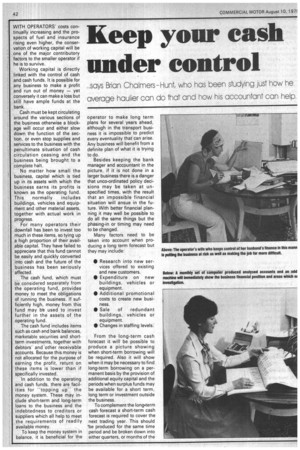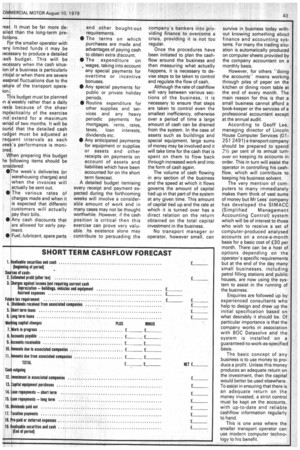Keep your cash under control
Page 44

Page 45

If you've noticed an error in this article please click here to report it so we can fix it.
_says Brian Chalmers-Hunt who has been studying just how he average haulier can do that and how his accountant can help,
WITH OPERATORS costs continually increasing and the prospects of fuel and insurance rising even higher, the conservation of working capital will be one of the major contributory factors to the smaller operator if he is to survive.
Working capital is directly linked with the control of cash and cash funds. It is possible for any business to make a profit and run out of money — yet conversely it can make a loss but still have ample funds at the bank.
Cash must be kept circulating around the various sections of the business otherwise a blockage will occur and either slow down the function of the section, or even stop supplies and services to the business with the penultimate situation of cash circulation ceasing and the business being brought to a complete halt.
No matter how small the business, capital which is tied up in its assets with which the business earns its profits is known as the operating fund.
This normally includes buildings, vehicles and equipment and other material assets, together with actual work in progress For many operators their downfall has been to invest too much in these items, so tying up a high proportion of their available capital. They have failed to appreciate that this fund cannot be easily and quickly converted into cash and the future of the business has been seriously affected_ The cash fund, which must be considered separately from the operating fund, provides money to meet the obligations of running the business. If sufficiently high, money from this fund may be used to invest further in the assets of the operating fund.
The cash fund includes items such as cash and bank balances, marketable securities and shortterm investments, together with debtors' and-other receivable accounts. Because this money is not allocated for the purpose of earning the profit, return on these items is lower than if specifically invested.
In addition to the operating and cash funds, there are facilities for "topping up" the money system. These may include short-term and long-term loans to the business and the indebtedness to creditors or suppliers which all help to meet the requirements of readily available money.
To keep the money system in balance, it is beneficial for the operator to make long term plans for several years ahead, although in the transport business it is impossible to predict every eventuality that can arise. Any business will benefit from a definite plan of what it is trying to do.
Besides keeping the bank manager and accountant in the picture, if it is not done in a larger business there is a danger that unco-ordinated policy decisions may be taken at unspecified times, with the result that an impossible financial situation will ansue in the future. With better financial planning it may well be possible to do all the same things but the phasing-in or timing may need to be changed.
Many factors need to be taken into account when producing a long term forecast but they may include: • Research into new services offered to existing and new customers.
• Expenditure on new buildings, vehicles or equipment.
• Additional promotional costs to create new business.
• Sale of redundant buildings, vehicles or equipment.
• Changes in staffing levels.
From the long-term cash forecast it will be possible to produce a picture showing when short-term borrowing will be required. Also it will show when it may be necessary to find long-term borrowing on a permanent basis by the provision of additional equity capital and the periods when surplus funds may be available for a short term, long term or investment outside the business.
To complement the long-term cash forecast a short-term cash forecast is required to cover the next trading year. This should 'be produced for the same time period and be broken down into either quarters, or months of the 'ear. It must be far more deailed than the long-term prefictions.
F r the smaller operator with rer limited funds it may be iec ssary to produce a detailed as budget. This will be lee ssary when the cash situaion of a business is particularly :riti al or when there are severe easonal fluctuations due to the iat re of the transport opera
ion.
T is budget must be planned in a weekly rather than a daily Iasi because of the sheer rnp acticality of the exercise nd extend for a maximum eri.d of two months. It will be ou d that the detailed cash lud et must be adjusted at req ent intervals as each vee 's performance is moniore&
When preparing this budget he following items should be ons dered: • The week's deliveries (or warehousing charges) and when the invoices will actually be sent out.
• The various rates of charges made and when it is expected that different customers will actually pay their bills.
• Any cash discounts that are allowed for early payment.
• Fuel, lubricant, spare parts and other bought-out requirements.
• The terms on which purchases are made and advantages of paying cash to obtain extra discount.
• The expenditure on wages, taking into account any special payments for overtime or incentive bonuses.
• Any special payments for public or private holiday periods.
• Routine expenditure for other supplies and -services and any heavy periodic payments for mortgages, rents, rates,
taxes, loan interests, dividends etc.
• Any anticipated payments for equipment or supplies or assets and other receipts on payments on account of assets and liabilities which have been accounted for on the short term forecast.
A detailed budget itemising every receipt and payment expected during the forthcoming weeks will involve a considerable amount of work and in many cases may not be thought worthwhile. However, if the cash position is critical then this exercise can prove very valuable. Its existence alone may contribute to persuading the company's bankers into providing finance to overcome a crisis, providing it is not too regular.
Once the procedures have been initiated to plan the cashflow around the business and then measuring what actually happens, it is necessary to devise steps to be taken to control and regulate the flow of cash.
Although the rate of cashflow will vary between various sections of the business, it is necessary to ensure that steps are taken to control even the smallest inefficiency, otherwise over a period of time a large amount of cash can be drained from the system. In the case of assetssuch as buildings and special equipment, large sums of money may be involved and it will take time for the cash that is spent on them to flow back through increased work and into the form of cash again.
The volume of cash flowing in any section of the business and the speed at which it flows governs the amount of capital tied up in that part of the system at any given time. This amount of capital tied up and the rate at which it is turned over has a direct relation on the return obtained on the total capital investment in the business.
No transport manager or operator, however small, can survive in business today without knowing something about finance and accounting systems. For many the trading situation is automatically produced on computer sheets provided by the company accountant on a monthly basis.
However, for others -doing the accounts"' means working through piles of paper on the kitchen or dining room table at the end of every month. The main reason for this is that a small business cannot afford a book-keeper or the services of a professional accountant except at the annual audit.
According to Geoff Lee, managing director of Lincoln House Computer Services (01251 2491) a transport company should be prepared to spend 21/2 per cent of its annual turnover on keeping its accounts in order. This in turn will assist the operator in controlling his cashflow, which will contribute to keeping his business solvent.
The very mention of computers to many immediately makes them think of vast sums of money but Mr Lees' company has developed the SIMACC (Simplified Management Accounting Control) system which will be of interest to those who wish to receive a set of computer-produced analysed accounts on a once-a-month basis for a basic cost of E30 per month. There can be a host of options depending on the operator's specific requirements but at the end of the day many small businesses, including petrol filling stations and public houses, are now using the system to assist in the running of the business.
Enquiries are followed up by experienced consultants who help to design and draw up the initial specification based on what desirably it should be. Of particular importance is that the company works in association with BOC Datasolve and the system is installed on a guaranteed-to-work-as-specified basis.
The basic concept of any business is to use money to produce a profit. Unless this money produces an adequate return on the investment, then the capital would better be used elsewhere. To assist in ensuring that there is an adequate return on the money invested, a strict control must be kept on the accounts, with up-to-date and reliable cashflow information regularly to hand.
This is one area where the smaller transport operator can use modern computer technology to his benefit.




































































































